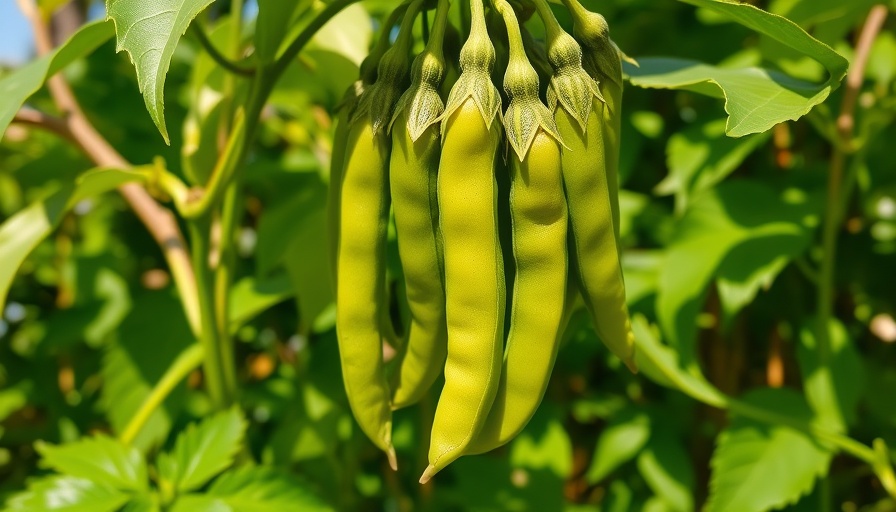
Unleashing the Potential of Winged Beans in Your Garden
Winged beans (Psophocarpus tetragonolobus) are not just another exotic plant to add to your garden; they are a nutritional powerhouse waiting to flourish in your backyard. Having first encountered these unique legumes during a family trip to Hawaii, I was instantly drawn to their unusual ruffled, wing-like pods, which sparked my curiosity about their cultivation and culinary potential. If you're looking to diversify your garden with vibrant, edible plants, winged beans should be at the top of your list.
Why Grow Winged Beans? The Nutritional Benefits
Winged beans are noteworthy not only for their intriguing appearance but also for their impressive nutritional profile. These legumes can contain up to 35% protein in their seeds and 20% in their tubers, which resemble potatoes. Packed with essential vitamins such as B1, B2, B3, B6, B9, C, A, and E, they serve as a fantastic staple for health-conscious consumers. Furthermore, their versatility extends to their all-edible nature, including their nutritious flowers that can be tossed into salads for a unique flair.
Growing Conditions for Optimal Harvests
To grow winged beans successfully, it's essential to understand their environmental needs. They thrive in USDA Growing Zones 10 to 12, ideally under full sun with loose, humus-rich, and well-draining soil with a pH level of 6.0 to 7.5. In areas where winters can be harsh, they can still be cultivated as annuals during the warmer months, though they might not achieve their full potential height of 15 feet in just one growing season. This makes them perfect for small garden spaces as they maximally utilize vertical space.
Delving into the Cultivation Techniques
Establishing your winged beans begins with sowing the seeds directly into the soil after the last frost, allowing them to germinate in a warm, sunny spot. These vining plants appreciate support, so consider using trellises, which not only helps them grow upward but also saves precious garden space. Water the plants consistently while avoiding waterlogging. Key actions include:
- Regularly check for pests; winged beans may attract aphids and other insects.
- Utilize organic pesticides whenever necessary to maintain sustainability.
- Monitor for fungal diseases commonly affecting beans, ensuring good airflow around the plants.
Harvesting and Preserving Your Crop
When the pods are firm and crispy, it’s time to harvest. For younger, tender beans, ensure they are picked promptly to encourage further pod production. The edible flowers can be obtained during this time as well, providing an added, delicate flavor to your meals. If you find yourself with an abundance, preserving your winged beans can be done through drying or blanching and freezing for future use, adding to your eco-friendly gardening lifestyle.
Delicious Ways to Incorporate Winged Beans in Your Meals
From stir-frying to steaming, winged beans can be incorporated in various culinary preparations. Their mild flavor makes them a delightful side dish or a satisfying addition to main courses. Experiment with dishes that highlight their unique shape and vibrant color. Recipes can range from simple sautés to innovative salads that showcase these beauties alongside other garden-fresh ingredients.
Encouraging Urban Gardening and Sustainable Living
As more individuals turn to home gardening as a means of self-sufficiency, growing winged beans is a testament to how urban and suburban homeowners can cultivate a diverse array of plants while improving their nutritional intake. By embracing the idea of growing not only for aesthetics but also for sustenance, gardeners can foster a deeper connection with their environment and their food source. This commitment to planting and growing edibles contributes to climate-friendly gardening practices, reducing carbon footprints and promoting food security in local communities.
In conclusion, the journey of growing winged beans is not just about cultivation; it's about embracing a lifestyle that values health, sustainability, and community connection. Whether you're a novice or an experienced gardener, the addition of winged beans can enhance your garden’s diversity and provide you with nutritious, delicious food.
Ready to grow your own winged beans? Start today and transform your garden into a thriving ecosystem filled with life and nourishment!
 Add Row
Add Row  Add
Add 




 Add Row
Add Row  Add
Add 

Write A Comment